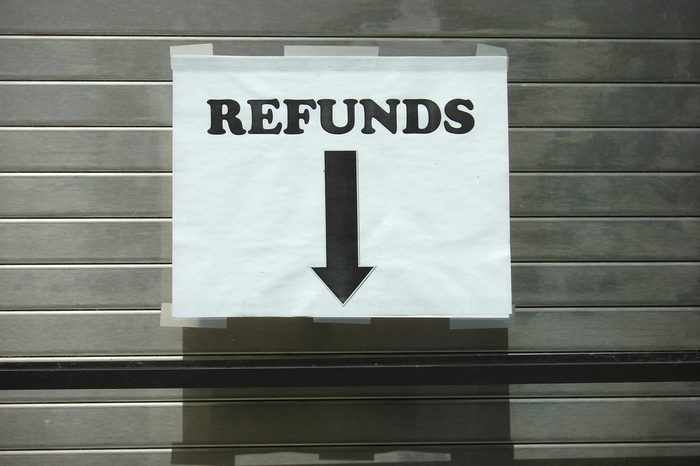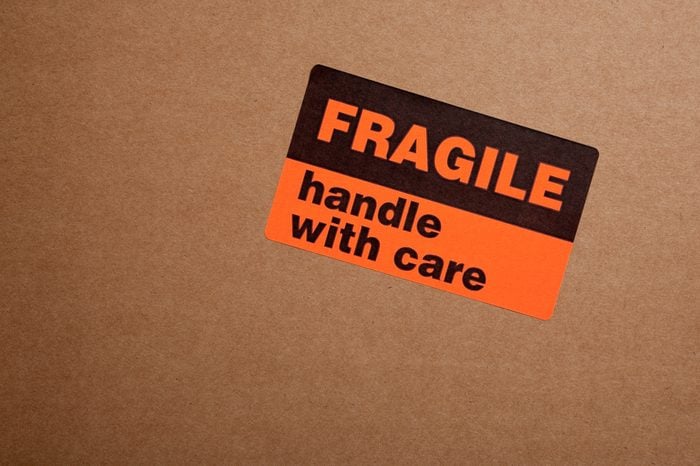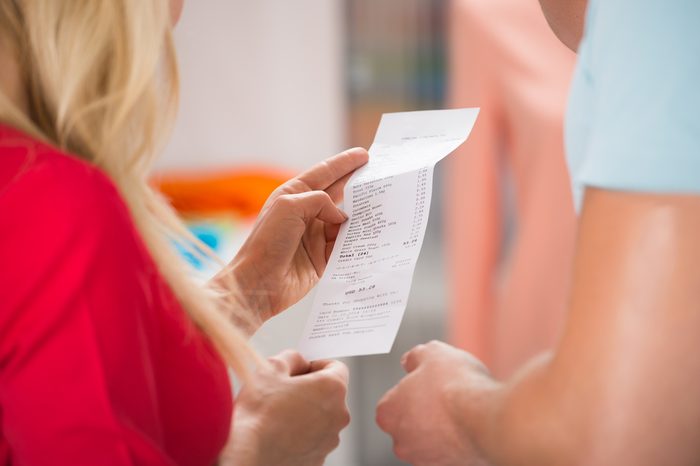
First, do your research
Before walking into a store with a return, do some research about that store’s return and exchange policies. Trae Bodge, a smart shopping expert, says it’s important to familiarize yourself with each store’s individual policy since all stores have different ones. The United States has no federal laws saying that stores must give customers a refund, and as such, return policies vary greatly by store. Some stores are more likely to give you your money back; others will offer store credit or a replacement for the item. Be prepared and keep an open mind about what you’ll receive for your return. But the next time you go to make a return, try these tricks that are sure to boost your chances of getting your money back. Or shop at the stores with the absolute best return policies.

Is there something wrong with it?
Many retailers will offer you a full refund if you’ve purchased a faulty item. If it’s broken or doesn’t work, you’re well within your rights to request your money back (as long as you’re not responsible for the breakage, of course!). Before you head to the store, snap a picture of the item so that you have proof that it is, in fact, faulty.

Know the right time to try a return
Try going at a less busy time, Bodge advises. “The busier the store is, the longer the line. And the longer the line, the more likely it is that the representative will be feeling overwhelmed,” says Bodge. While actual days/times that are less crowded vary by store, in general, you want to steer clear of weekends. To save more money for yourself, try these habits of people who are great at saving money.

Don’t wait too long
Many stores have 30- to 60-day limits on returns and exchanges. Regardless of the return policy, though, you’ll want to aim to return the item as soon as possible (though you should avoid the first few days after Christmas, as they’ll be incredibly hectic). “The more time you give the merchant to re-sell the item, the better,” says Bodge. That being said, the coronavirus pandemic has motivated many retailers to extend their return windows, with some allowing purchases made as early as October to be returned through January. Others have extended their limits by two weeks, 30 days, and more. Home Depot and Kohl’s have a whopping 180-day deadline for returning most items. MoneyTalksNews has a comprehensive list of 2020-2021 holiday season return policies. Here are some ways COVID-19 changed shopping forever.

Try to keep tags on and have the receipt
Obviously, making a return with tags on and the receipt is a lot easier, says Bodge, but even without them, it’s not impossible. If you don’t have the receipt, some stores will accept another form of “proof of purchase,” such as your bank or credit card statement that documents the purchase. Also, come equipped with the packaging the item came in (if you have it) as well as the card you used to pay. You may just be able to get your money back if you have those things. In some cases, though, if you don’t have the receipt, you’ll likely get store credit, not cash. Here again, you want to be on the ball with your return—the longer you wait, the more difficult it will be to get the highest value for your return, Bodge shares. You can also try these almost effortless ways to save money.

If it’s an online purchase
If you purchased the item through Amazon, and it’s damaged or defective in some way, head to the site’s Online Return Center. You can send back a damaged item within 30 days of receipt of shipment. Though there are some items, like groceries or gift cards, that can’t be returned through Amazon, you should be able to send most items back and get a refund. The Returns Center site offers both “Replacement” and “Refund” options for most items. However, Amazon recommends trying to get in touch with the manufacturer if you’re trying to return the item after 30 days, or if the item came with parts missing. eBay has a similar policy; if you received a damaged item, eBay’s Money Back Guarantee allows you to get a refund, even if the seller says they don’t accept returns. Watch out for this online shopping scam that the FBI warns about.

Be persistent
“Don’t take no for an answer,” says Bodge. “If the representative gives you information about your return that you feel is unfair, ask to speak to a manager.” Here are some other secret tips sales associates won’t tell you.

But be respectful and don’t be a jerk
Remember the old adage “You catch more flies with honey than vinegar,” and apply it here. “Customer service reps have a very tough job. Be nice,” says Bodge. “Also, some reps have leeway with store policies, but if you’re a jerk, you probably won’t be given any flexibility.”

The Internet is your friend
If you aren’t sure where an item that you got as a gift is from, take to the World Wide Web. “Google the item and see which stores carry it,” says Bodge. “Then, check their return policies for returns without a receipt. The store with the most flexible policy wins!”

Consider selling it online
If you can’t figure out where your gift came from or the store won’t take it back, selling it online is an option. Suggests Bodge, “There’s Amazon Marketplace, Facebook Marketplace, eBay, Craigslist, Poshmark for clothing…to name a few.” Hopefully, you can at least get some money in your pocket for the item. Here’s everything you need to know about using Facebook Marketplace.

If you bought it…and then it went on sale
You purchased that must-have item as soon as you saw it. But then, a few days later, you went back to the store…and noticed that it was on sale. Great. Luckily, you don’t have to throw your arms up in aggravation and accept your fate! Check to see if the store or retailer you purchased the item from offers a “price adjustment refund” or “price drop refund”; many do. Unfortunately, though, you may only have a certain number of days to get this price adjustment—and it may be fewer days than the regular return policy allows. So make sure to do your research. You may also have to return the item and buy it again at the sale price, rather than simply getting the difference in money handed right to you…but hey, that’s still the same amount of money going back into your pocket. Finally, some stores may just offer you the price difference amount in store credit. Read on for the secret store policies that can save you lots of money.
Sources:
- Trae Bodge, smart shopping expert
- FindLaw: “Return Policies and Refunds”
- MoneyTalksNews: “COVID-19 Prompts Return Policy Changes”
- Money Manifesto: “3 Ways To Get A Price Drop Refund After You Purchase An Item”
- USA Today: “How to take advantage of post-purchase price drops”